Assemble the Team and Engage Leadership for Perinatal Safety
AHRQ Safety Program for Perinatal Care
Slide 1: AHRQ Safety Program for Perinatal Care

Assemble the Team and Engage Leadership for Perinatal Safety
Slide 2: Learning Objectives

Image: Four ascending steps show the learning objectives:
- Understand the importance of your CUSP team.
- Develop a strategy to build a successful team.
- Identify characteristics of successful teams and barriers to team performance.
- Define roles and responsibilities of team members.
Slide 3: The L&D Unit-Based CUSP Team

- Understands that patient safety culture is local.
- Is composed of engaged frontline providers who take ownership of patient safety.
- Includes staff members who have different levels of experience.
- Is tailored to include members based on clinical intervention.
- Meets regularly (at least monthly).
- Has adequate resources.
Slide 4: Success Depends on L&D Unit Team

Team members—
- Start and sustain the initiative.
- Contribute to positive results through their engagement and belief in the project.
Team should include—
- Frontline providers with varying backgrounds and expertise.
- Members with a shared commitment to—
- Engage other team members.
- Develop educational materials.
- Execute the project.
Slide 5: Team Members

- Nurses (including nurse educator, nurse manager, nurse midwives, nurse anesthetists).*
- Physicians* (OB/GYN, family medicine, pediatricians, anesthesiologist).
- Executive partners.*
- Pharmacists.
- Patient safety officers.
- Chief quality officers.
- Ancillary staff.
- Infection prevention specialists.
*Key team members.
Slide 6: Team Characteristics

Image: Venn Diagram depicting the similarities and differences between CUSP and TeamSTEPPS. CUSP teams have diverse local "opinion leaders" and dissenters that are willing to help to spread the intervention.
Both CUSP and TeamSTEPPS teams emphasize strong team leadership, identify defined team roles and responsibilities, maintain clear values and shared vision, and contain mechanisms for collaboration and feedback.
TeamSTEPPS teams develop a strong sense of collaborative trust and confidence, manage and optimize performance outcomes and develop a strong sense of collective trust, team identity and confidence.
Slide 7: Team Characteristics

Image: Venn Diagram depicting the similarities and differences between CUSP and TeamSTEPPS. CUSP teams have diverse local "opinion leaders" and dissenters that are willing to help to spread the intervention.
Both CUSP and TeamSTEPPS teams emphasize strong team leadership, identify defined team roles and responsibilities, maintain clear values and shared vision, and contain mechanisms for collaboration and feedback.
TeamSTEPPS teams develop a strong sense of collaborative trust and confidence, manage and optimize performance outcomes and develop a strong sense of collective trust, team identity and confidence.
Slide 8: Team Characteristics

Image: Venn Diagram depicting the similarities and differences between CUSP and TeamSTEPPS. CUSP teams have diverse local "opinion leaders" and dissenters that are willing to help to spread the intervention.
Both CUSP and TeamSTEPPS teams emphasize strong team leadership, identify defined team roles and responsibilities, maintain clear values and shared vision, and contain mechanisms for collaboration and feedback.
TeamSTEPPS teams develop a strong sense of collaborative trust and confidence, manage and optimize performance outcomes and develop a strong sense of collective trust, team identity and confidence.
Slide 9: Team Characteristics

Image: Venn Diagram depicting the similarities and differences between CUSP and TeamSTEPPS. CUSP teams have diverse local "opinion leaders" and dissenters that are willing to help to spread the intervention.
Both CUSP and TeamSTEPPS teams emphasize strong team leadership, identify defined team roles and responsibilities, maintain clear values and shared vision, and contain mechanisms for collaboration and feedback.
TeamSTEPPS teams develop a strong sense of collaborative trust and confidence, manage and optimize performance outcomes and develop a strong sense of collective trust, team identity and confidence.
Slide 10: Team Member Characteristics

Image: Venn Diagram depicting the similarities and differences between CUSP and TeamSTEPPS.
CUSP team member characteristics include maintaining a positive outlook, emphasizing dedication to project aims, focusing on the "big picture," and practicing attention to detail.
Both CUSP and TeamSTEPPS team members understand their roles and responsibilities.
TeamSTEPPS team member characteristics include quality information and feedback, skillful conflict management and stress reduction for the whole team through better performance.
Slide 11: Team Member Characteristics

Image: Venn Diagram depicting the similarities and differences between CUSP and TeamSTEPPS.
CUSP team member characteristics include maintaining a positive outlook, emphasizing dedication to project aims, focusing on the "big picture", and practicing attention to detail.
Both CUSP and TeamSTEPPS team members understand their roles and responsibilities.
TeamSTEPPS team member characteristics include quality information and feedback, skillful conflict management and stress reduction for the whole team through better performance.
Slide 12: Team Member Characteristics
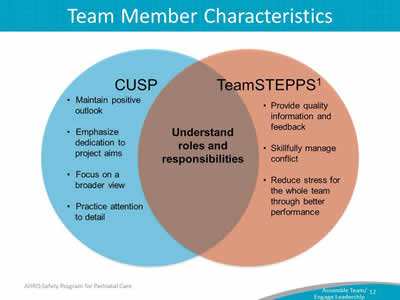
Image: Venn Diagram depicting the similarities and differences between CUSP and TeamSTEPPS.
CUSP team member characteristics include maintaining a positive outlook, emphasizing dedication to project aims, focusing on the "big picture," and practicing attention to detail.
Both CUSP and TeamSTEPPS team members understand their roles and responsibilities.
TeamSTEPPS team member characteristics include quality information and feedback, skillful conflict management and stress reduction for the whole team through better performance.
Slide 13: Building Your CUSP Team
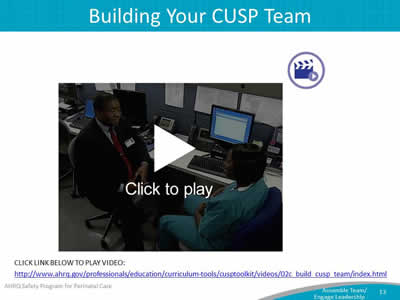
Image: Opening shot of "Physician Engagement" video with the words "Click to play".
Go to Link Below To Play Video:
https://www.ahrq.gov/hai/cusp/videos/02c-build-cusp-team/index.html
Slide 14: CUSP Teams' Group Processes
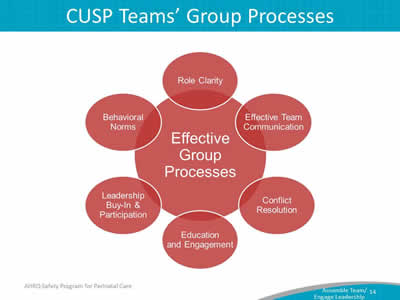
Image: Effective group processes include: role clarity, effective team communication, conflict resolution, education and engagement, leadership buy-in and support and norms.
Slide 15: Team Performance
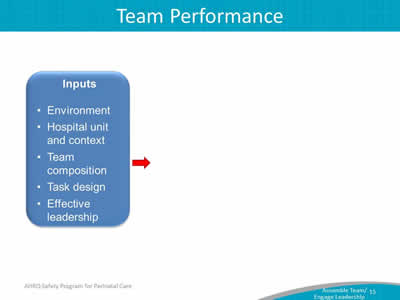
Image: A text box captioned "Inputs" shows the following list:
- Environment.
- Hospital unit and context.
- Team composition.
- Task design.
- Effective leadership.
A red arrow points to the right.
Slide 16: Team Performance
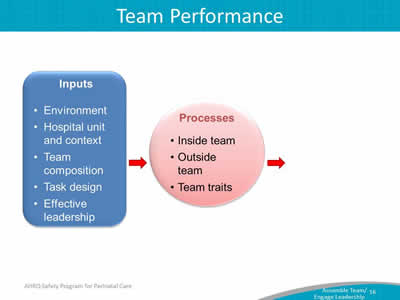
Image: A text box captioned "Inputs" shows the following list:
- Environment.
- Hospital unit and context.
- Team composition.
- Task design.
- Effective leadership.
A red arrow points to the right, to a circle captioned "Processes" and the following list:
- Inside team.
- Outside team.
- Team traits.
A second red arrow points to the right.
Slide 17: Team Performance
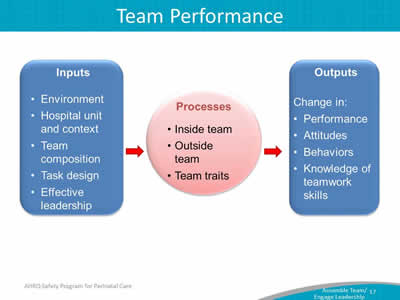
Image: A text box captioned "Inputs" shows the following list:
- Environment.
- Hospital unit and context.
- Team composition.
- Task design.
- Effective leadership.
A red arrow points to the right, to a circle captioned "Processes" and the following list:
- Inside team.
- Outside team.
- Team traits.
A second red arrow points to the right, to a text box captioned "Outputs" and the following list:
Change in:
- Performance.
- Attitudes.
- Behaviors.
- Knowledge of teamwork skills.
Slide 18: Barriers to Team Performance1
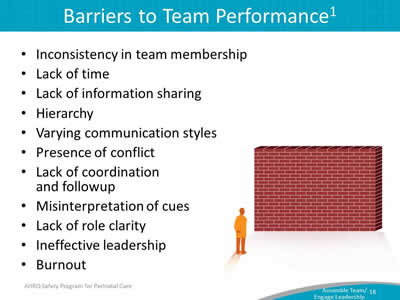
- Inconsistency in team membership.
- Lack of time.
- Lack of information sharing.
- Hierarchy.
- Varying communication styles.
- Presence of conflict.
- Lack of coordination and followup.
- Misinterpretation of cues.
- Lack of role clarity.
- Ineffective leadership.
- Burnout.
Image: Team member standing before a brick wall.
Slide 19: Stages of Engagement
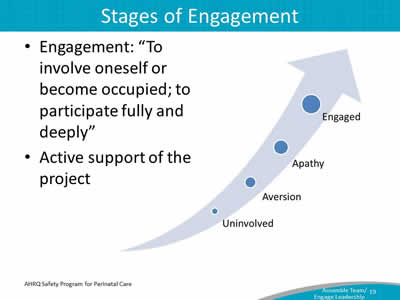
- Engagement: "To involve oneself or become occupied; to participate fully and deeply."
- Active support of the project.
Image: The range of engagement for CUSP team members encompasses: uninvolved, aversion, apathy, and engaged.
Slide 20: Engage Team Members Using the 4 Es2

Image: This has a diagram with three "gear" shapes in orange shades, and arrows indicating the gears turning; the gears represent Senior leaders, Staff, and Team leaders.
Gears symbolizing the roles of staff, unit team leaders and senior leadership depict the interconnected and dependent relationship that exists between each aspect of the unit team.
The roles of staff, team leaders and senior leaders are interconnected when unit teams apply the 4 Es. The 4 Es require teams and their leaders to Educate, Engage, Execute and Evaluate their involvement in the CUSP program.
Slide 21: Engage Team Members Using the 4 Es2
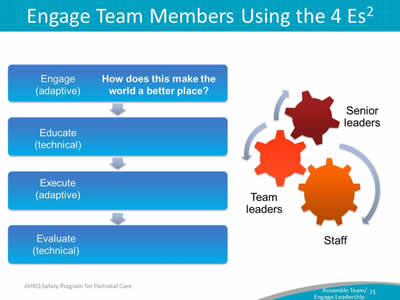
Image: This has a diagram with three "gear" shapes in orange shades, and arrows indicating the gears turning; the gears represent Senior leaders, Staff, and Team leaders.
Gears symbolizing the roles of staff, unit team leaders and senior leadership depict the interconnected and dependent relationship that exists between each aspect of the unit team.
The roles of staff, team leaders and senior leaders are interconnected when unit teams apply the 4 Es. The 4 Es require teams and their leaders to Educate, Engage, Execute and Evaluate their involvement in the CUSP program.
Slide 22: Engage Team Members Using the 4 Es2
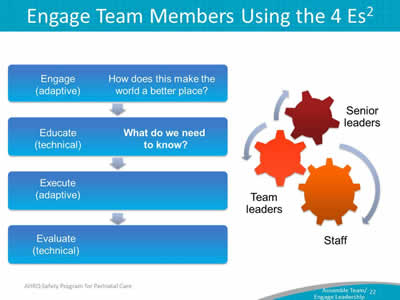
Image: This has a diagram with three "gear" shapes in orange shades, and arrows indicating the gears turning; the gears represent Senior leaders, Staff, and Team leaders.
Gears symbolizing the roles of staff, unit team leaders and senior leadership depict the interconnected and dependent relationship that exists between each aspect of the unit team.
The roles of staff, team leaders and senior leaders are interconnected when unit teams apply the 4 Es. The 4 Es require teams and their leaders to Educate, Engage, Execute and Evaluate their involvement in the CUSP program.
Slide 23: Engage Team Members Using the 4 Es2
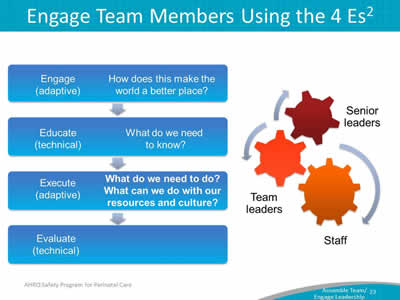
Image: This has a diagram with three "gear" shapes in orange shades, and arrows indicating the gears turning; the gears represent Senior leaders, Staff, and Team leaders.
Gears symbolizing the roles of staff, unit team leaders and senior leadership depict the interconnected and dependent relationship that exists between each aspect of the unit team.
The roles of staff, team leaders and senior leaders are interconnected when unit teams apply the 4 Es. The 4 Es require teams and their leaders to Educate, Engage, Execute and Evaluate their involvement in the CUSP program.
Slide 24: Engage Team Members Using the 4 Es2
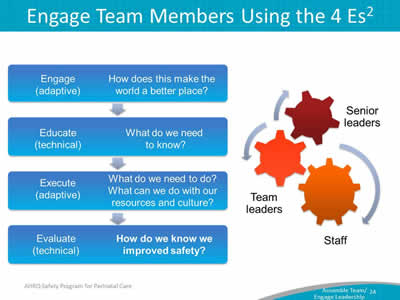
Image: This has a diagram with three "gear" shapes in orange shades, and arrows indicating the gears turning; the gears represent Senior leaders, Staff, and Team leaders.
Gears symbolizing the roles of staff, unit team leaders and senior leadership depict the interconnected and dependent relationship that exists between each aspect of the unit team.
The roles of staff, team leaders and senior leaders are interconnected when unit teams apply the 4 Es. The 4 Es require teams and their leaders to Educate, Engage, Execute and Evaluate their involvement in the CUSP program.
Slide 25: The CUSP Leader's Role
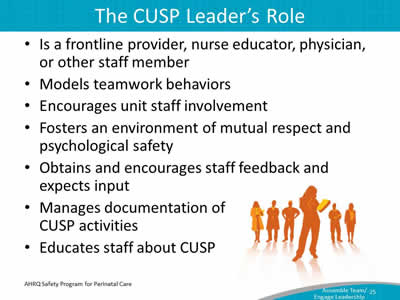
- Is a frontline provider, nurse educator, physician, or other staff member.
- Models teamwork behaviors.
- Encourages unit staff involvement.
- Fosters an environment of mutual respect and psychological safety.
- Obtains and encourages staff feedback and expects input.
- Manages documentation of CUSP activities.
- Educates staff about CUSP.
Slide 26: Engage Physicians on the CUSP Team
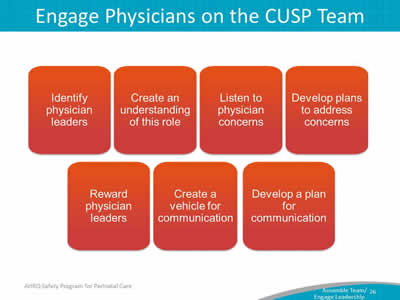
Image: Identify physician leaders, create a forum for this role, listen to physician concerns, develop plans to address concerns, reward physician leaders, create a vehicle for communication, develop a plan for communications.
Slide 27: The Physician Champion's Role
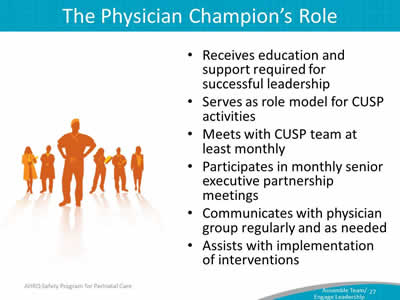
- Receives education and support required for successful leadership.
- Serves as role model for CUSP activities.
- Meets with CUSP team at least monthly.
- Participates in monthly senior executive partnership meetings.
- Communicates with physician group regularly and as needed.
- Assists with implementation of interventions.
Slide 28: Physician Engagement
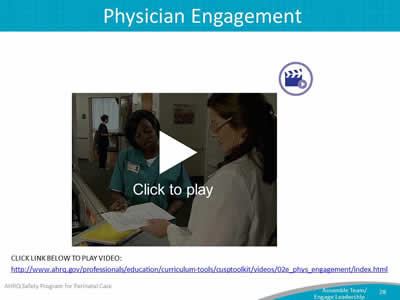
Image: Opening shot of "Physician Engagement" video with the words "Click to play".
Go to Link Below To Play Video:
https://www.ahrq.gov/hai/cusp/videos/02e-phys-engagement/index.html
Slide 29: Engage Other CUSP Team Members
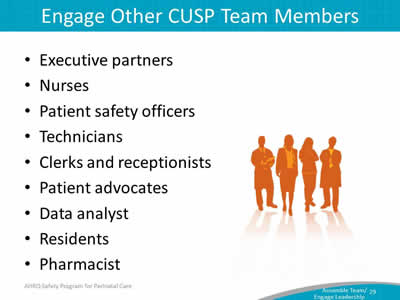
- Executive partners.
- Nurses.
- Patient safety officers.
- Technicians.
- Clerks and receptionists.
- Patient advocates.
- Data analyst.
- Residents.
- Pharmacist.
Slide 30: The Senior Executive's Role
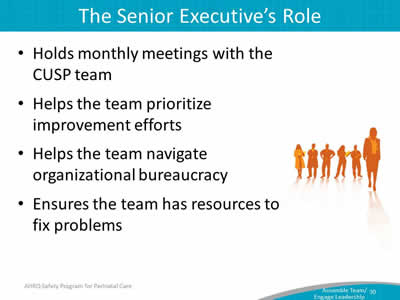
- Holds monthly meetings with the CUSP team.
- Helps the team prioritize improvement efforts.
- Helps the team navigate organizational bureaucracy.
- Ensures the team has resources to fix problems.
Slide 31: The Senior Executive's Role
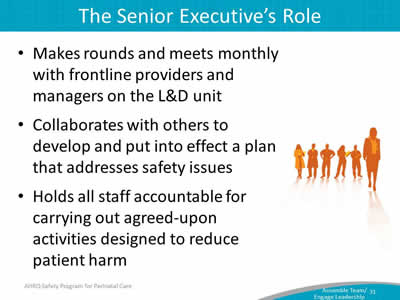
- Makes rounds and meets monthly with frontline providers and managers on the L&D unit.
- Collaborates with others to develop and put into effect a plan that addresses safety issues.
- Holds all staff accountable for carrying out agreed-upon activities designed to reduce patient harm.
Slide 32: Senior Executives Support Both Technical and Adaptive Work of Change
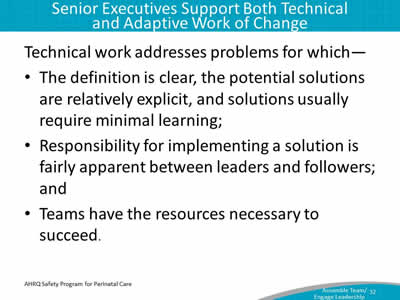
Technical work addresses problems for which—
- The definition is clear, the potential solutions are relatively explicit, and solutions usually require minimal learning.
- Responsibility for implementing a solution is fairly apparent between leaders and followers.
- Teams have the resources necessary to succeed.
Slide 33: Senior Executives Support Both Technical and Adaptive Work of Change
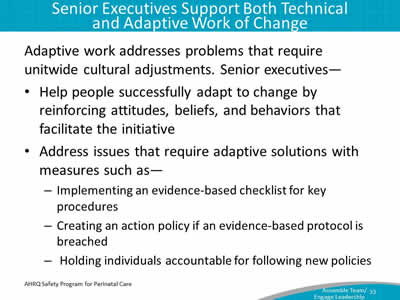
Adaptive work addresses problems that require unitwide cultural adjustments. Senior executives—
- Help people successfully adapt to change by reinforcing attitudes, beliefs, and behaviors that facilitate the initiative.
- Address issues that require adaptive solutions with measures such as—
- Implementing an evidence-based checklist for key procedures.
- Creating an action policy if an evidence-based protocol is breached.
- Holding individuals accountable for following new policies.
Slide 34: Senior Executives Support Both Technical and Adaptive Work of Change
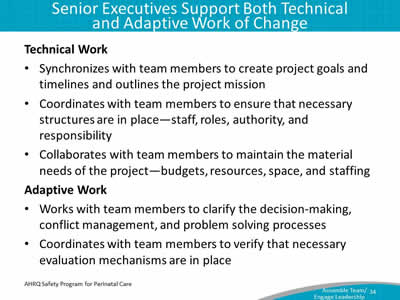
Technical Work:
- Synchronizes with team members to create project goals and timelines and outlines the project mission.
- Coordinates with team members to ensure that necessary structures are in place—staff, roles, authority, and responsibility.
- Collaborates with team members to maintain the material needs of the project—budgets, resources, space, and staffing.
Adaptive Work:
- Works with team members to clarify the decision-making, conflict management, and problem solving processes.
- Coordinates with team members to verify that necessary evaluation mechanisms are in place.
Slide 35: Senior Executive Collaborates To Develop and Implement a Plan Addressing Safety Issues
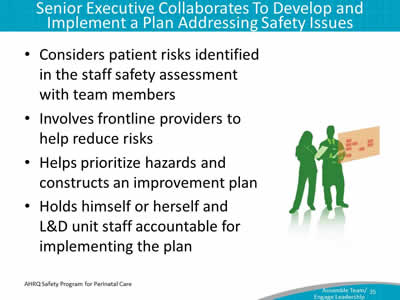
- Considers patient risks identified in the staff safety assessment with team members.
- Involves frontline providers to help reduce risks.
- Helps prioritize hazards and constructs an improvement plan.
- Holds himself or herself and L&D unit staff accountable for implementing the plan.
Slide 36: Senior Executive's Characteristics
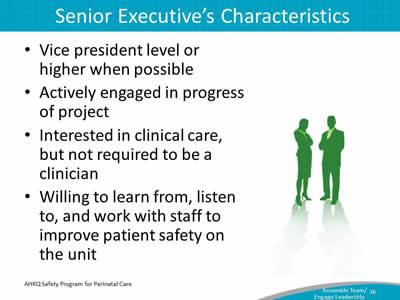
- Vice president level or higher when possible.
- Actively engaged in progress of project.
- Interested in clinical care, but not required to be a clinician.
- Willing to learn from, listen to, and work with staff to improve patient safety on the unit.
Slide 37: The Challenges of Partnering With a Senior Executive
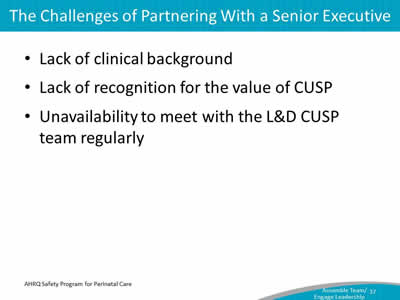
- Lack of clinical background.
- Lack of recognition for the value of CUSP.
- Unavailability to meet with the L&D CUSP team regularly.
Slide 38: How To Engage Your Senior Executive and Develop Shared Accountability for the Work
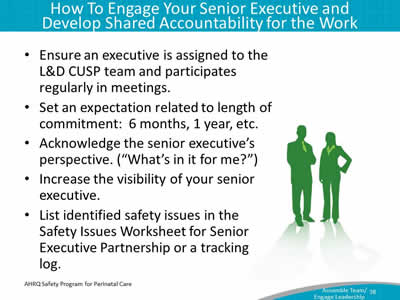
- Ensure an executive is assigned to the L&D CUSP team and participates regularly in meetings.
- Set an expectation related to length of commitment: 6 months, 1 year, etc.
- Acknowledge the senior executive's perspective. ("What's in it for me?")
- Increase the visibility of your senior executive.
- List identified safety issues in the Safety Issues Worksheet for Senior Executive Partnership or a tracking log.
Slide 39: The Nurse Manager's Role
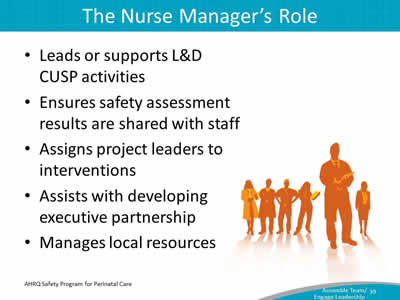
- Leads or supports L&D CUSP activities.
- Ensures safety assessment results are shared with staff.
- Assigns project leaders to interventions.
- Assists with developing executive partnership.
- Manages local resources.
Slide 40: The Leadership and Management Roles of the Nurse Manager
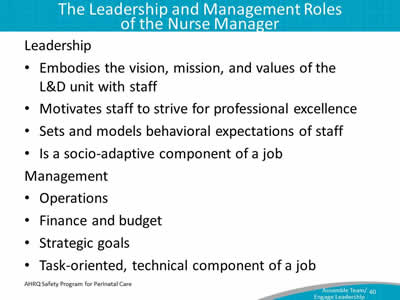
Leadership:
- Embodies the vision, mission, and values of the L&D unit with staff.
- Motivates staff to strive for professional excellence.
- Sets and models behavioral expectations of staff.
- Is a socio-adaptive component of a job Management.
Management:
- Operations.
- Finance and budget.
- Strategic goals.
- Task-oriented, technical component of a job.
Slide 41: Frameworks Useful for Nurse Managers
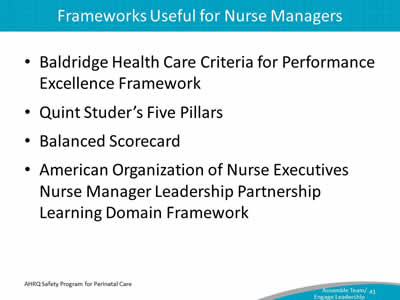
- Baldridge Health Care Criteria for Performance Excellence Framework.
- Quint Studer's Five Pillars.
- Balanced Scorecard.
- American Organization of Nurse Executives Nurse Manager Leadership Partnership Learning Domain Framework.
Slide 42: The Patient Safety Coordinator's/Officer's Role
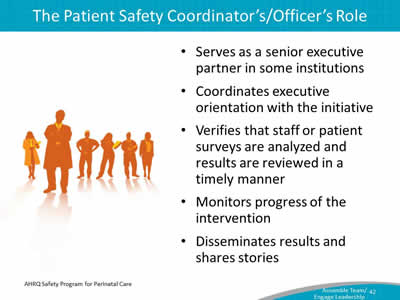
- Serves as a senior executive partner in some institutions.
- Coordinates executive orientation with the initiative.
- Verifies that staff or patient surveys are analyzed and results are reviewed in a timely manner.
- Monitors progress of the intervention.
- Disseminates results and shares stories.
Slide 43: Psychological Safety3
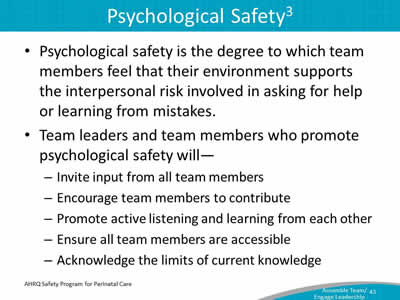
- Psychological safety is the degree to which team members feel that their environment supports the interpersonal risk involved in asking for help or learning from mistakes.
- Team leaders and team members who promote psychological safety will—
- Invite input from all team members.
- Encourage team members to contribute.
- Promote active listening and learning from each other.
- Ensure all team members are accessible.
- Acknowledge the limits of current knowledge.
Slide 44: Psychological Safety
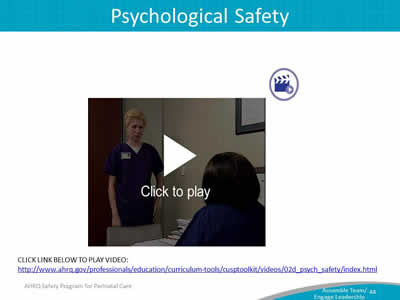
Image: Opening shot of "Psychological Safety" video with the words "Click to play".
Go to Link Below To Play Video:
https://www.ahrq.gov/hai/cusp/videos/02d-psych-safety/index.html
Slide 45: Assemble the Team: What the Team Needs To Do
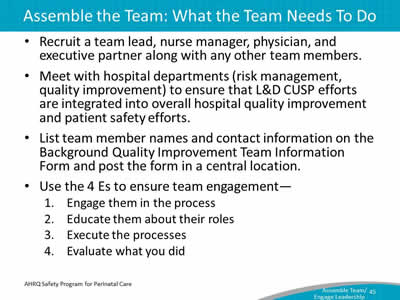
- Recruit a team lead, nurse manager, physician, and executive partner along with any other team members.
- Meet with hospital departments (risk management, quality improvement) to ensure that L&D CUSP efforts are integrated into overall hospital quality improvement and patient safety efforts.
- List team member names and contact information on the Background Quality Improvement Team Information Form and post the form in a central location.
- Use the 4 Es to ensure team engagement—
- Engage them in the process.
- Educate them about their roles.
- Execute the processes.
- Evaluate what you did.
Slide 46: CUSP Tools
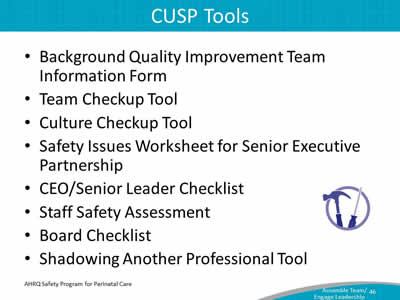
- Background Quality Improvement Team Information Form.
- Team Checkup Tool.
- Culture Checkup Tool.
- Safety Issues Worksheet for Senior Executive Partnership.
- CEO/Senior Leader Checklist.
- Staff Safety Assessment.
- Board Checklist.
- Shadowing Another Professional Tool.
Slide 47: Summary
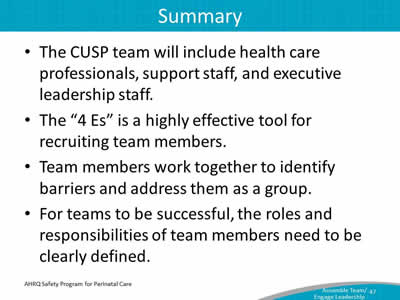
- The CUSP team will include health care professionals, support staff, and executive leadership staff.
- The "4 Es" is a highly effective tool for recruiting team members.
- Team members work together to identify barriers and address them as a group.
- For teams to be successful, the roles and responsibilities of team members need to be clearly defined.
Slide 48: References
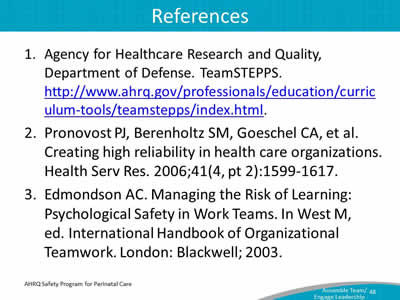
- Agency for Healthcare Research and Quality, Department of Defense. TeamSTEPPS. https://www.ahrq.gov/teamstepps-program/index.html.
- Pronovost PJ, Berenholtz SM, Goeschel CA, et al. Creating high reliability in health care organizations. Health Serv Res 2006;41(4, pt 2):1599-1617.
- Edmondson AC. Managing the Risk of Learning: Psychological Safety in Work Teams. In West M, ed. International Handbook of Organizational Teamwork. London: Blackwell; 2003.
Slide 49: Disclaimers
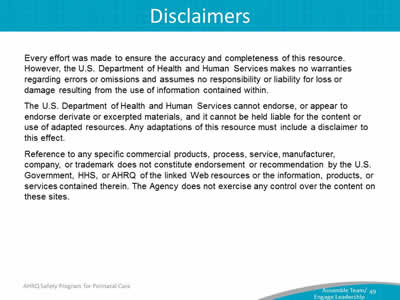
Every effort was made to ensure the accuracy and completeness of this resource. However, the U.S. Department of Health and Human Services makes no warranties regarding errors or omissions and assumes no responsibility or liability for loss or damage resulting from the use of information contained within.
The U.S. Department of Health and Human Services cannot endorse, or appear to endorse derivate or excerpted materials, and it cannot be held liable for the content or use of adapted resources. Any adaptations of this resource must include a disclaimer to this effect.
Reference to any specific commercial products, process, service, manufacturer, company, or trademark does not constitute endorsement or recommendation by the U.S. Government, HHS, or AHRQ of the linked Web resources or the information, products, or services contained therein. The Agency does not exercise any control over the content on these sites.



